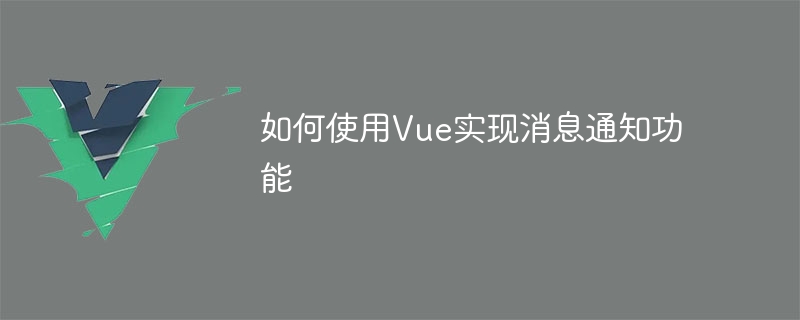

How to use Vue to implement message notification function
With the increasing popularity of web applications, message notification has become an indispensable function. Message notifications can help users get important tips and reminders in a timely manner, improving user experience. As a popular front-end framework, Vue provides a wealth of tools and APIs that can easily implement message notification functions.
This article will introduce how to use Vue to implement a simple message notification function and provide specific code examples.
Please create a file named "Notification.vue" under the src/components folder and fill it in according to the following code:
<template>
<div class="notification">
<div class="notification-text">{{ message }}</div>
<button class="notification-close-button" @click="closeNotification">关闭</button>
</div>
</template>
<script>
export default {
props: ['message'],
methods: {
closeNotification() {
this.$emit('close'); // 触发close事件,通知父组件关闭当前通知
}
}
}
</script>
<style scoped>
.notification {
position: fixed;
bottom: 10px;
left: 50%;
transform: translateX(-50%);
padding: 10px;
background-color: #f0f0f0;
border: 1px solid #ccc;
border-radius: 4px;
box-shadow: 0 2px 4px rgba(0, 0, 0, 0.1);
display: flex;
align-items: center;
}
.notification-text {
flex: 1;
margin-right: 10px;
}
.notification-close-button {
background-color: #fff;
border: none;
color: #888;
}
</style>This notification component contains a display message content text box and a close button. When the close button is clicked, the component will trigger an event named "close" to notify the parent component to close the current notification.
Please create a file named "NotificationBar.vue" under the src/components folder and fill it in according to the following code:
<template>
<div class="notification-bar">
<button class="notification-add-button" @click="addNotification">添加通知</button>
<div v-for="notification in notifications" :key="notification.id">
<Notification :message="notification.message" @close="closeNotification(notification.id)"></Notification>
</div>
</div>
</template>
<script>
import Notification from './Notification.vue';
export default {
components: {
Notification
},
data() {
return {
notifications: []
}
},
methods: {
addNotification() {
const id = this.notifications.length + 1;
const message = `这是第${id}条通知`;
this.notifications.push({ id, message });
},
closeNotification(id) {
this.notifications = this.notifications.filter(notification => notification.id !== id);
}
}
}
</script>
<style scoped>
.notification-bar {
position: fixed;
top: 10px;
right: 10px;
}
.notification-add-button {
background-color: #409eff;
border: none;
color: #fff;
padding: 8px 16px;
margin-bottom: 10px;
}
</style>This notification bar component contains an "Add Notifications button and an area to display notifications. Each time you click the "Add notification" button, a notification is added to the notification list. When you click the close button of a notification, the notification bar component will remove the notification from the list.
Please modify the entry file according to the following code:
import Vue from 'vue';
import NotificationBar from './components/NotificationBar.vue';
new Vue({
render: h => h(NotificationBar),
}).$mount('#app');Now, our Vue project is ready to run the project and view the results.
npm run serve
After the project is started, in the browser Open the access address (usually http://localhost:8080), and you will see an interface containing an "Add Notification" button and a notification bar. Each time you click the "Add notification" button, a notification will be added to the notification bar. When you click the close button of a notification, the notification disappears from the notification bar.
So far, we have successfully implemented a simple message notification function.
Summary:
This article introduces how to use Vue to implement a simple message notification function. By creating notification components and notification bar components, and using Vue's data binding and event mechanism, we can easily manage and display multiple notifications. Through this example, a basic implementation can be provided for the message notification function in the project, which can be expanded and optimized according to specific needs.
I hope this article can help you understand how to use the message notification function in the Vue project, and bring some inspiration to your project development. Happy developing with Vue!
The above is the detailed content of How to use Vue to implement message notification function. For more information, please follow other related articles on the PHP Chinese website!